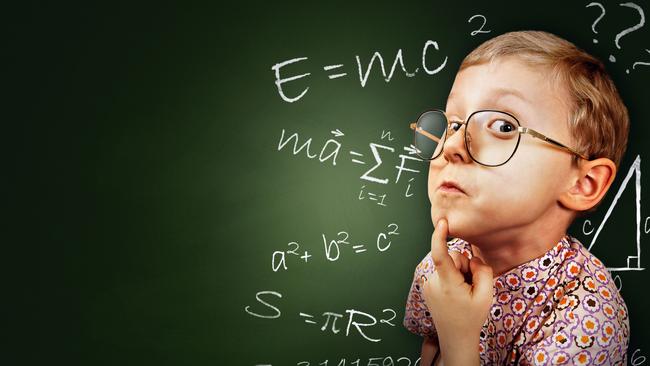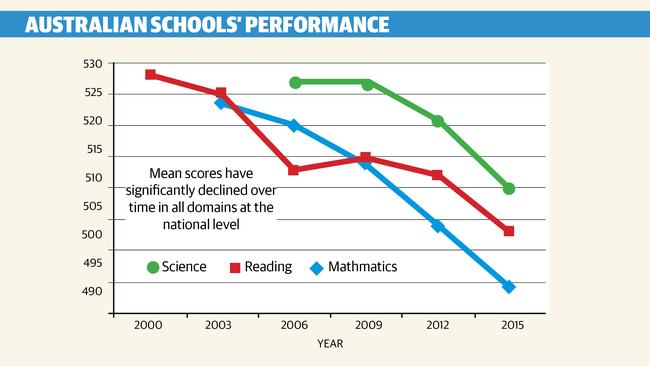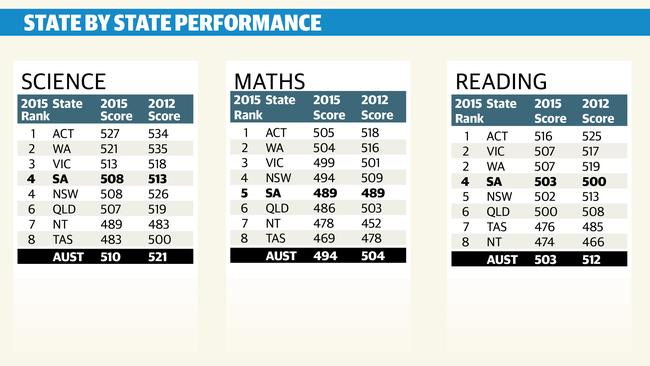Australian students record poor results in Program for International Student Assessment (PISA) tests
ANOTHER international testing system shows Australia is not just falling behind other countries but that today’s students are way behind those of a decade ago.

SA News
Don't miss out on the headlines from SA News. Followed categories will be added to My News.
ANOTHER international testing system shows Australia is not just falling behind other countries but that today’s students are way behind those of a decade ago. Education Reporter TIM WILLIAMS reports.
FIRST it was flatlining results in the NAPLAN national literacy and numeracy tests.
Then last week it was the Trends in International Mathematics and Science Study showing Australian Year 4 and Year 8 students falling behind their peers in countries such as Kazakhstan and Bulgaria.
Now the results of another international testing system are in, and they’re even worse.
While the TIMSS showed many other countries were overtaking Australia, the Program for International Student Assessment (PISA) makes clear that the abilities of Australian students are in “absolute decline”.

In science literacy, they are half a year behind in their learning when compared with Australian students who took part in 2006. In maths, they are a year behind those who took the tests in 2003, and reading ability has also declined by a year since 2000.
PISA tests are conducted around the world every three years.
About 550,000 15-year-old students from 72 countries, including 35 OECD nations, sat the tests last year.
The Australian sample of more than 14,500 students came from 758 schools, including 98 in SA across both the public and private sectors.
From the 2012 to 2015 tests, Australia slipped six places in maths, from 19th to 25th, and two places in reading, from 14th to 16th. In science we rose from 16th to 14th, but that was because Liechtenstein didn’t participate this time and Germany’s results tumbled.
More worrying is the mean scores of Australian students in all test areas being in decline over the longer term.
The Australian Council for Educational Research released its report on the 2015 results last night, saying we are getting worse at preparing students for the everyday challenges of adult life.
“Results from the 2015 Trends in International Mathematics and Science Study released last week indicate that, although we are slipping backwards relative to other countries, Australian student achievement against the mathematics and science curriculum is unchanged,” said director of educational monitoring and research Dr Sue Thomson.
“Results from PISA 2015 suggest the situation is much worse: Australian students’ ability to apply their mathematical and scientific knowledge to real-life situations is falling not only relative to other countries but also in an absolute sense.”
Dr Thomson said Australia performed equal 10th in science, equal 12th in reading and equal 20th in mathematics, after accounting for insignificant differences between countries.
Students from Singapore, the best-performing nation, were the equivalent of 2.3 years of schooling ahead of Australian teens in maths literacy, 1.5 years ahead in scientific literacy and a year ahead in reading.

Relative to other states and territories, SA ranks more favourably in PISA than in NAPLAN. SA was equal fourth in science, despite a slight dip in mean score from 2012, fifth in maths with no score change, and fourth in reading with a slight score rise.
All states and territories except Victoria and the NT had large declines in science during the past decade. Reading results were more stable in that time everywhere except Queensland, where they fell markedly. Long-term maths results were a mixed bag, with SA’s decline not significant.
Federal Education Minister Simon Birmingham said Australia continued to beat OECD averages but “our performance is slipping”.
“Commonwealth funding for schools has increased by 50 per cent since 2003 while our results are going backwards,” he said
Senator Birmingham said funding levels were important, but Australia had the fifth highest education spend ing in the OECD, demonstrating how money was spent mattered more.
The Australian Education Union said the results showed the final two years of the needs-based funding system known as Gonski, which the Federal Government has abandoned, must be implemented up to 2019.
“We now have gaps equivalent to three years of schooling between students from rich and poor areas, and that is what is dragging our results down,” the union said.
The SA Education Department said: “We performed at a significantly higher level than the international average in science literacy, with 10 per cent of our students identified as high performers.”
Overall SA results were “relatively stable”, it said.



